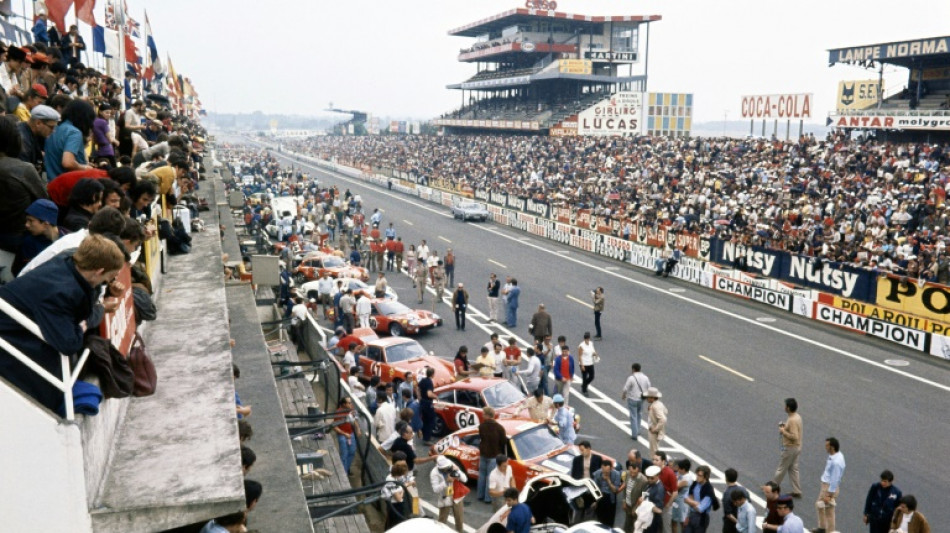
BCC
3.4200


The Le Mans 24 Hours celebrates its centenary on Friday - the mythic race's history marked by triumph and tragedy, and a hefty sprinkling of Hollywood stardust.
Since 33 cars set off in the rain for the very first edition on May 26, 1923, Le Mans has gone on to earn an exalted place in motorsport's calendar alongside Formula One's Monaco Grand Prix and the Indy 500.
Only one driver - the late Graham Hill - has succeeded in taking the chequered flag in all three of motor racing's 'triple crown'.
While Toyota have proved unstoppable during the recent Hybrid era, the early Le Mans years were dominated by Bentley
The British marque's five wins between 1924 and 1930 came from a team of mechanics and millionaire Woolf Barnato - the legendary 'Bentley boys'.
A Bugatti took seventh in 1930 with Odette Siko and Marguerite Mareuse sharing the driving - the best placing for an all-female crew to this day.
World War Two forced Le Mans into hibernation but on its return, in 1949, a newish Italian constructor by the name of Ferrari, took the first of its nine wins.
Withdrawing from the main category in 1973 the now iconic 'prancing horse' stable is making its return for the 100th anniversary party when the cars line up again for this year's event on June 10.
The 1950s delivered up a fierce rivalry between Jaguar, Mercedes, Ferrari and Aston Martin.
It was also during this decade that disaster struck Le Mans.
In 1955 the Mercedes, with France's Pierre Levegh at the wheel, crashed in front of the stands on the main straight.
Levegh's car was ripped to shreds, its engine exploding, killing him and 80 spectators.
Ferrari stacked up six wins in the first half of the Swinging Sixties.
US car tycoon Henry Ford II, irked by Enzo Ferrari's attitude in a failed bid to buy the Italian constructor, set out to build a machine capable of putting the brakes on Ferrari's Le Mans run.
His sense of injustice proved a powerful motivator, and Ford duly constructed a car to win the 1966 edition.
- 'Terrified' -
One driver who remembers that race vividly is four-time winner Henri Pescarolo.
Called up at the last minute by Matra he recalled a stint during the night with "headlamps that didn't shine much light, bends that weren't lit up, at the wheel of a car not easy to drive and surrounded by much faster Ferraris and Fords in full battle.
"I was completely terrified! There were cars from every angle going at scary speeds," he said.
"Even when I was involved in serious enough accidents later on, I can't say I was ever as scared as I was then."
That famous duel of man's ego and machine was immortalised in the 2019 film "Ford v Ferrari" starring Matt Damon and Christian Bale.
The 24 Hour classic has ignited the imagination of numerous Hollywood A-listers over the years.
Paul Newman famously finished second in 1979 aged 54, Patrick Dempsey raced it four times, Steve McQueen used the 1970 edition to shoot scenes of his film 'Le Mans', and in 2016 Brad Pitt gave the celebrated command 'Gentlemen, start your engines'.
The year before Newman's starring role at the Sarthe circuit, Belgian driver Jacky Ickx had helped Ford to a fourth straight win, ending a famous Le Mans tradition in the process.
Until then, the start involved drivers running to their cars, a practice Ickx considered dangerous.
His protest, in walking to his car and consequently setting off last, triggered the race organisers, the Automobile Club de l'Ouest, to do away with it.
Ickx went on to win the '69 race, by a miniscule 100 metre margin - the first of his six wins.
The following year Porsche's name went on the Le Mans roll of honour for the first of their record 19 wins.
Another German constructor, Audi, was to help Denmark's Tom Kristensen to the drivers' record of nine wins.
Next month's centenary, the 91st edition, promises to be a special affair, with a sold-out 300,000 crowd burning the midnight oil to watch the new Le Mans hypercar and a top tier grid comprising Toyota, Peugeot, Ferrari, Porsche, Cadillac, Glickenhaus, and Vanwall.
(H.Schneide--BBZ)